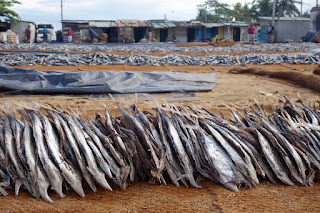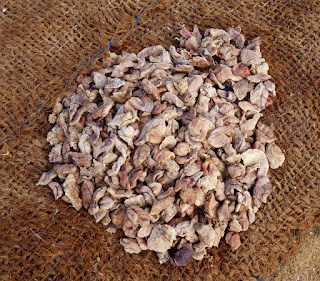I love to get away straight after Christmas, avoiding that post-festive slump and also those dreadfully depressing first two weeks of January! So this time a friend and I headed off to Sri Lanka on Boxing Day.
We were doing an Intrepid trip for 2 weeks around the island - ‘Circle of Sri Lanka’.
We caught a taxi from the airport to our starting hotel and were entertained by the newspaper-lined transport…but it’s practical as it turned out that it rains a fair bit in Sri Lanka and so the newspaper is to stop wet muddy shoes covering the car’s carpets.
The Fish Market
Negombo Lagoon’s shallow waters has supported the local fishing industry for centuries, providing crabs, shrimp, lobsters, cuttlefish and many fish. The fish market here (called ‘Lellama’) is the second largest in the country.
We visited the market mid-morning but it wasn’t fully open yet because of the morning’s rain so the drying fish were mostly covered by black tarpaulin, looking a bit like mass graves.
But very soon boats starting coming in with a range of fish. The boats come in two forms: oruvas (a sailing canoe) and paruvas (man-powered catamaran) which came to Sri Lanka via the Portuguese traders in the 17th century.
We watched them unload their nets and some of their catches.
And prep the fish for sale.
In the market itself we saw sheer fish (which I also ate in Negombo), crabs, shark, tuna, ray and plenty of other fish.
Anything not sold at the auction to the retailers that day is then dried. Interestingly their auction style goes backwards, with the price reducing to encourage people to bid.
The ‘reject fish’ is first salted in barrels.
Then washed in sea water and laid out in the sun for 2-3 days.
The fisherman live in poverty in shanty thatch palm villages near the water and rely on income from the fish, but some supplement it with selling other items as well. Here are coconut oil, fruits and treacle.
As we were leaving, the fisherman were starting to uncover all the drying fish making for some great pics!
Beaches
Negombo has one of the best beaches on Sri Lanka’s west coast and key to its tourism.
Parts of the beach are maintained by the tourist hotels, whilst others are always busy with the fisherman. Diving and water sports are also popular with a 50 year old shipwreck (Kudapaduwa) providing an artificial reef.
Food
We didn’t have long in Negombo, so only ate out once for dinner. We went to a nearby guesthouse/restaurant called ‘Sea Joy’.
To celebrate being by the sea we tucked into large plates of grilled sheer fish and prawns with salad and veggies.
Negombo is also known for producing ceramics, brass items and cinnamon. The wild cinnamon in the area was said to be "the very best in the universe as well as the most abundant” (according to wikipedia!).
Then it was time to head onto Anuradhapura, with some interesting sites on the way…













































Post a Comment